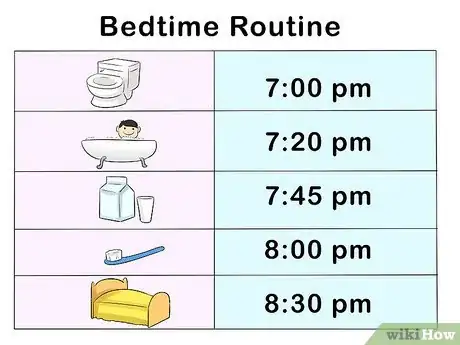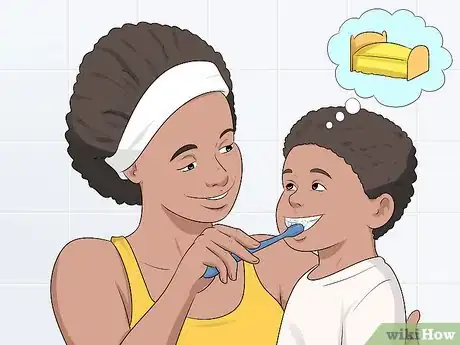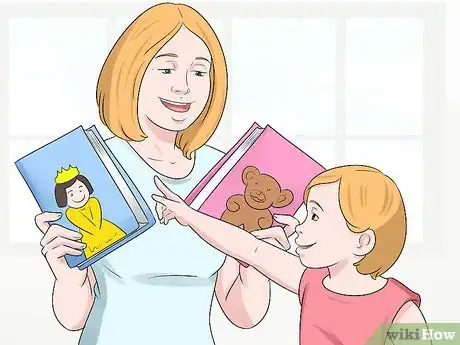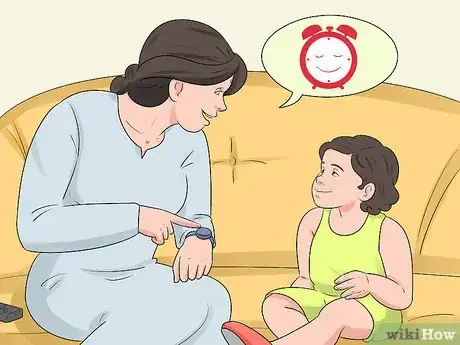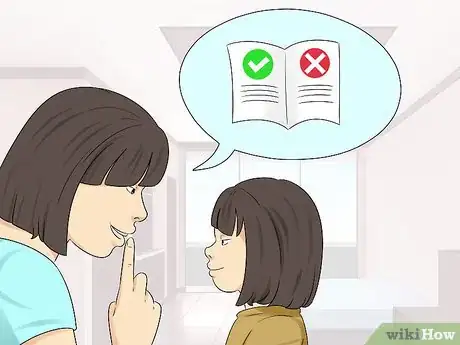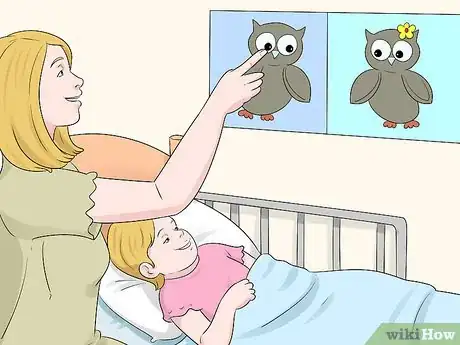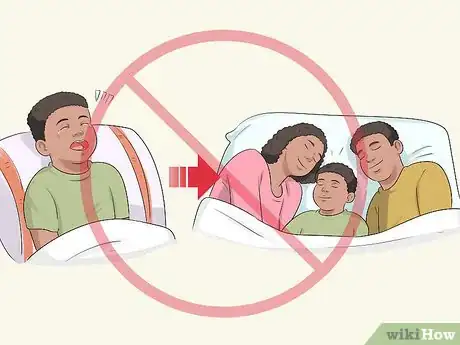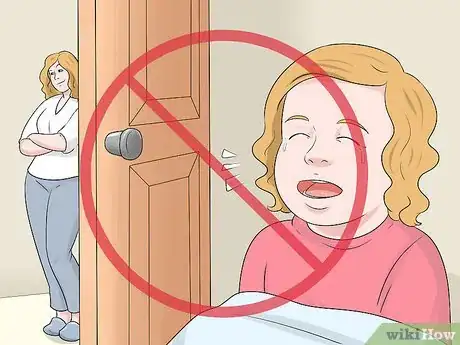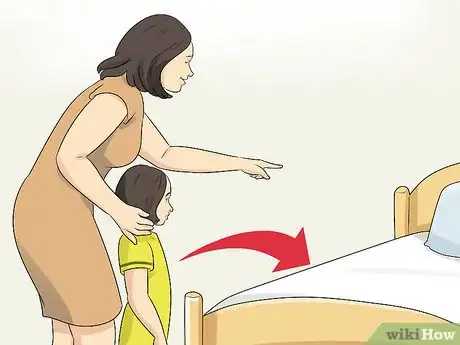This article was co-authored by Corey Fish, MD. Dr. Corey Fish is a practicing Pediatrician and the Chief Medical Officer at Brave Care, a pediatric healthcare company based in Portland, Oregon. Dr. Fish has over 10 years of experience in pediatric care and is a member of the American Academy of Pediatrics. Dr. Fish received a BS in Biology from Pacific Lutheran University in 2005, an MD from the University of Washington School of Medicine in 2009, and completed his Pediatric Residency at the University of Texas Southwestern Medical School in 2012.
This article has been viewed 466,438 times.
Many parents of toddlers quickly come to realize why it’s called “The Terrible Twos.” Besides the common two year old challenges, you might have a difficult time getting them to go to sleep alone at night. Your toddler may have grown accustomed to their usual bedtime ritual, and any change to that routine is likely to be met with resistance. However, if you make a bedtime routine, address tantrums, and avoid common mistakes, you can get your two year old to stop crying and go to sleep alone each night.
Steps
Establishing a Bedtime Routine
-
1Serve your child a dinner that’s low in sugar. Eating high-sugar foods can cause your child to have low blood sugar. Low blood sugar levels specifically can trigger cravings for more sweets and can make toddlers feel negative and cry. Try to stick with whole foods and serve your toddler more fruits and vegetables. Also, avoid serving soda or fruit-flavored drinks, as these tend to contain a lot of sugar.[1]
-
2Take your toddler’s activity level down a notch during early evening hours. Calm your child down about an hour or so before dinner time. Make the switch from wild play to calming activities like reading a book or singing songs.
- Shut off the TV just before dinner and don't turn it on until after your toddler has gone to bed.
- Give your child a warm bath after dinner to help calm both their mind and body. Try adding some lavender soap or use a lavender-infused shampoo, which has calming properties.
Advertisement -
3Stick with the same bedtime each night. Decide on a bedtime and make sure you start your nightly routine at the same time each night. After just a week of going to bed at the same time, most children will adjust to this schedule and come to expect it each night.[2]
-
4Go through all the steps to prepare for bed. Signal to your child that bedtime is approaching to get them mentally prepared. Give them a bath, brush their teeth, and get out that security blanket or stuffed animal they love.[3]
-
5Let your toddler make bedtime decisions each night. Your child might experience anxiety because they feel they have no control over their bedtime routine. Give them some choices to alleviate this. Limit their options to keep their choices simple. For instance, let them decide which story to read at bedtime.
- Lay out two sets of pajamas on the bed and allow your toddler to choose which pair to wear each night.
- During bath time, ask which songs they would like to sing.
-
6Make sure all of their needs are met before bed. Before they get into bed, be sure they don’t need anything. Give them a few sips of water so they aren’t thirsty and make sure they’ve used the bathroom. You might also give them a nighttime snack like an apple so they aren’t hungry.
- Don’t give them too much water if they are potty training. You don’t want to wake up to an accident!
- If they keep making demands before bed, your toddler may be “fake” crying to get attention because they don't feel like going to sleep.
-
7Spend time together right before they go to sleep. Spending more time together before bed can help your child feel less needy as lights out approaches. Read them a story, talk about their day, and talk about what you’re looking forward to for tomorrow.[4]
-
8Stay within your toddler’s sight while they are adjusting to the new bedtime routine. This can help your two year old feel secure while transitioning to sleeping on their own. Do this for a week, and then begin leaving the room as soon as they are in bed.[5]
- Stay in the room and perform some simple, silent tasks while they lie in their crib or bed. Fold laundry, balance a checkbook, go through the mail or read a book.
- Explain to your toddler that you will remain in the room until they fall asleep, but that it's bedtime and not time to play or talk.
-
9Turn on their night light. Your child might not want to be alone because they are afraid of the dark, but this is a simple fix. Get them a night light for their room and leave it on for them so they aren’t scared.[6]
Avoiding Tantrums
-
1Limit TV time and certain TV programming. If your child is watching scary movies or TV shows, this might make them fearful of being alone at night. Allow them to only watch programs designed for kids their age. Try not to let them watch more than two hours of TV per day.
-
2Signal that bedtime is approaching. Ten minutes before bed, say “Would you like to go to bed now or in ten minutes?” Though they are likely to choose ten minutes from then, giving the option makes them feel more in control of bedtime, which can cut back on nightly power struggles.
-
3Play soothing lullabies. Your child might fall asleep faster if there is some calming music to put them to sleep. Some children, just like adults, do not like to sleep in quiet atmospheres. Dig out that old cell phone of yours and download a lullaby app like Baby Shusher or Lullabies for Babies to play them as they drift off.
-
4Set bedtime rules. Let your child know that they are not to get out of bed after you say goodnight. Though you should not punish your child for doing so, you need to be firm and hold tight to this rule. If they should break it, put them back in their bed and don’t allow them into yours. Don’t debate the rules with them if they they say they’re unfair.
-
5Create positive associations for them with their room. If they should want to get out of bed, remind them of how cool their room is. Doing so will encourage them to stay put.[7]
- Say, “Wow, if I were you I sure wouldn’t wanna leave this cool room. Look at that cool sticker on the wall and look at all these toys! This place is really fun.”
- If your child is used to playing in their room a lot, they may struggle to associate their room with sleeping. If this is the case, consider rearranging their room to clearly separate their playing area from their sleeping area.
-
6Reward your child. Make a “star chart” or some other system for your child and reward them for each night they sleep alone. Make a chart and place a star by each day that they sleep independently. If they go seven days straight sleeping alone, give them a bigger reward like a game or movie night.[8]
-
7Alternate bed time duties with your spouse. Consider having your spouse put your toddler to bed as well occasionally so that they get a chance to interact with both of you before bed. This can help to calm your child and help them feel more secure. However, be sure to stay consistent in your routines.
Dealing with Crying Fits
-
1Avoid giving in to your toddler’s cries and pleas to postpone bedtime. If you give in just once, you are indirectly communicating to your toddler that rules can be broken. A two year old can't understand special allowances like an older child can, so they'll only learn that they can cry and bargain to get what they want each night.
-
2Ask what's wrong, or what would help. Talking to the child may help you understand why they are crying, and how you can calm them. It can also encourage them to use their thinking skills and communication skills to express the problem. Try asking questions like:
- "What's wrong?"
- "How can I help you?"
- "What would make it easier for you to go to sleep?"
-
3Try validating their feelings. Empathizing with the child can help them feel calmer, because it shows them that you understand and care about their feelings.[9]
- "I know it's not fun to have to be done playing. I promise your toys will be ready for you in the morning."
- "It must be scary to feel worried that a monster is under your bed."
- "I'm sorry to hear that you've been having nightmares. I get nightmares too sometimes, and they're no fun. When I wake up, I remind myself that it wasn't real and I am safe."
-
4Calm their fears. If your child is scared to sleep alone, work around their fears to help calm them. Be sure to address any specific fears that your child may be experiencing. Ask them directly why they are crying and they will likely provide some sort of an answer. Make a little joke to make them laugh or redirect their fears.
- To redirect, you can say “Well, there aren’t any monsters, but do you know what is under your bed? Toys! Lots of toys!”
- If necessary, consider making adjustments to the room, like leaving the bedroom door open, to make your child feel more safe.
-
5Try explaining things to your toddler. While toddlers' ability to understand logic is limited, sometimes hearing your explanation is good enough for them. Try explaining the rules or how reality works, and see if they accept it.
- "We need to go to bed each night to help us stay healthy. Sleeping helps us have lots of energy for the morning so that we can have fun playing."
- "When I was your age, I worried that monsters were in my closet. And you know what? They never came. I was always safe, and I grew up into a big strong adult. I have never, ever heard of a monster hurting a child in real life."
- "We have a safety plan for tornadoes. If it happened, we would go to the basement and wait there, where it's safe. The sirens would warn us, so we would have enough time to grab our things and make sure everybody was safe. You don't need to worry about it, because we already have a plan. And there are no sirens, so that means no tornadoes are coming tonight."
- "I'm sorry I read you that story. I didn't realize it would scare you. I want to make sure you know that it's a story, and someone made it up. Made-up things aren't real, and they can't hurt you, even if you feel scared."
- "There are no volcanoes here. Scientists are very smart and good at finding volcanoes, and they found zero volcanoes here. The only volcanoes are far away, so far that they can't hurt us."
-
6Give them a little TLC. When your child is having a crying spell, sometimes all they need is a little affection. Pick them up and hug them for a few moments until they are calmer. Even though you might be fed up with their tantrums at bedtime, this might help soothe them and get them to sleep quicker.[10]
-
7Avoid the “Cry-it-Out” technique. Refrain from allowing your toddler to cry it out. Once your two year old cries to the point that they are inconsolable, it becomes increasingly difficult for them to stop crying. Children at this age do not understand how to regulate their emotions, and if left alone to cry at night, it can lead to feeling abandoned.[11]
- Allow them to cry for only five minutes at a time. If they continue, check on them and let them know that everything is going to be okay.
-
8Put them back in bed each time they get up. No matter how many times your toddler gets up in the middle of the night, it’s important that you put them back in bed each time. Even if they’re crying and upset, putting them back in their bed reinforces that you mean business. Your child will likely test you a few times, but don’t give in!
-
9Avoid getting angry or bent out of shape. It can be frustrating dealing with crying toddlers who refuse to go to sleep at night. It’s important that you remain in control and never lose your temper. Don’t yell or raise your voice, but do communicate your rules in a firm yet gentle tone. Though it can be tough, remember that you’re doing the best you can do. You got this![12]
- If you feel yourself getting angry and are worried about it getting the best of you, step out of the room for a moment. Go splash your face with some cool water or get a glass of juice from the fridge.
- You can also try counting to ten in your head and breathing deeply until you feel calm again.
Expert Q&A
-
QuestionShould a toddler have a bedtime routine?
 Corey Fish, MDDr. Corey Fish is a practicing Pediatrician and the Chief Medical Officer at Brave Care, a pediatric healthcare company based in Portland, Oregon. Dr. Fish has over 10 years of experience in pediatric care and is a member of the American Academy of Pediatrics. Dr. Fish received a BS in Biology from Pacific Lutheran University in 2005, an MD from the University of Washington School of Medicine in 2009, and completed his Pediatric Residency at the University of Texas Southwestern Medical School in 2012.
Corey Fish, MDDr. Corey Fish is a practicing Pediatrician and the Chief Medical Officer at Brave Care, a pediatric healthcare company based in Portland, Oregon. Dr. Fish has over 10 years of experience in pediatric care and is a member of the American Academy of Pediatrics. Dr. Fish received a BS in Biology from Pacific Lutheran University in 2005, an MD from the University of Washington School of Medicine in 2009, and completed his Pediatric Residency at the University of Texas Southwestern Medical School in 2012.
Pediatrician & Chief Medical Officer, BraveCare Yes! A bedtime routine will help your toddler fall asleep faster. It doesn't matter much exactly what you do during your routine—you might have a small snack, then a bath, then read a book together, for instance. However, do stick to a consistent routine as much as possible, and try to keep it at the same time each day.
Yes! A bedtime routine will help your toddler fall asleep faster. It doesn't matter much exactly what you do during your routine—you might have a small snack, then a bath, then read a book together, for instance. However, do stick to a consistent routine as much as possible, and try to keep it at the same time each day.
References
- ↑ http://www.parenting.com/article/sugar-does-it-make-kids-hyper
- ↑ https://ogradywellbeing.com/services/child-sleep/
- ↑ http://www.parents.com/kids/sleep/tips/how-do-i-teach-my-child-to-sleep-alone/
- ↑ https://ogradywellbeing.com/services/child-sleep/
- ↑ http://www.parents.com/kids/sleep/tips/how-do-i-teach-my-child-to-sleep-alone/
- ↑ http://www.parents.com/kids/sleep/tips/how-do-i-teach-my-child-to-sleep-alone/
- ↑ https://ogradywellbeing.com/services/child-sleep/
- ↑ http://www.parents.com/kids/sleep/tips/how-do-i-teach-my-child-to-sleep-alone/
- ↑ https://ogradywellbeing.com/services/child-sleep/
About This Article
It can be tough when your 2-year-old first starts to sleep alone, but by sticking to the same bedtime routine and comforting them, they should start to go to sleep without much trouble. Spend a little time with your child reading a book or talking to them about the next day before they go to sleep to help them settle in. For the first week, sit in the room where they can see you until they fall asleep so they don’t feel alone. After the first week, you’ll probably need to go in and comfort them when they start crying. If they don’t stop crying after 5 minutes, go and hold them and talk to them in a soothing voice. You can also add a night light or play some recorded lullabies on a speaker to help them sleep without you there. For more tips from our co-author, including how to help your child feel more in control of their bedtime, read on!

